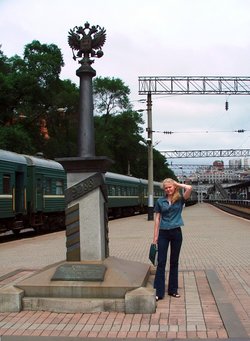Trans-Siberian Railway
|
|
Trans_siberian_railroad_large.png
The Trans-Siberian Railway or Trans-Siberian Railroad (Транссибирская магистраль, Транссиб in Russian, or Transsibirskaya magistral', Transsib), built 1891-1916, is a network of railways connecting European Russia with Russian Far East provinces. At 9,289 kilometres (5,772 miles) and spanning 8 time zones, it is the longest railway in the world. The main route is the Trans-Siberian line, which runs from Moscow to Vladivostok, passing through Nizhny Novgorod on the Volga, Perm on the Kama River, Yekaterinburg in the Urals, Omsk on the Irtysh, Novosibirsk on the Ob, Krasnoyarsk on the Yenisei, Irkutsk near Lake Baikal's southern extremity, Chita and then Khabarovsk. (From 1956 to 2001 the trains went via Yaroslavl instead of Nizhny Novgorod). In 2002 the electrification has been completed. Around 30% of Russian exports travel on the line.
A second primary route is the Trans-Manchurian line, which coincides with the Trans-Siberian as far as Tarskaya, a few hundred miles east of Baikal. From Tarskaya the Trans-Manchurian heads southeast into China and makes its way down to Beijing.
The third primary route is the Trans-Mongolian line, which coincides with the Trans-Siberian as far as Ulan Ude on Baikal's eastern shore. From Ulan-Ude the Trans-Mongolian heads south to Ulaan-Baatar before making its way southeast to Beijing.

In 1991, a fourth route running further to the north was finally completed, after more than five decades of sporadic work. Known as the Baikal Amur Mainline, this recent extension departs from the Trans-Siberian line several hundred miles west of Lake Baikal and passes the lake at its northernmost extremity. It reaches the Pacific to the northeast of Khabarovsk, at Sovetskaya Gavan (i.e., Soviet Haven, a.k.a. Sovgavan, Sovietgavan and earlier Imperatorskaya Gavan, i.e., Imperial Haven). While this route provides access to Baikal's stunning northern coast, it also passes through some rather forbidding terrain.
History
Russia's longstanding desire for a Pacific port was realised with the founding of Vladivostok in 1860. By 1880, Vladivostok had grown into a major port city, and the lack of adequate transportation links between European Russia and its Far Eastern provinces soon became an obvious problem. Full time construction on the Trans-Siberian Railway began in 1891. Similar to the First Transcontinental Railroad in the USA, Russian engineers started construction at both ends and worked towards the center. From Vladivostok the railway was laid north along the right bank of the Ussuri River to Khabarovsk at the Amur River becoming the Ussuri railway.
In 1890 a bridge across the river Ural was built and the new railroad entered Asia. The bridge across the Ob River was built in 1898 and the small city Novonikolaevsk, founded in 1883, metamorphosed into a large Siberian center - Novosibirsk city. In 1898 the first train reached Irkutsk and the shore of Lake Baikal. The railroad ran on and on to the East, across the Shilka and the Amur rivers and soon reached Khabarovsk. The Vladivostok - Khabarovsk branch was built a bit earlier in 1897.
Convict labour, from Sakhalin Island and other places, and Russian soldiers were drafted into railway-building service. One of the largest obstacles was Lake Baikal, some forty-one miles east from the Irkutsk station. Lake Baikal is more than 400 miles (640 km) long and almost 6,000 feet (1,800 m) deep. The train line ended on each side of the lake and a special icebreaker ferryboat was purchased from England to connect the railway. In the winter sleighs were used to move passengers and cargo from one side of the lake to the other until the completion of the Lake Baikal spur along the southern edge of the lake. With the completion of the Amur River line north of the Chinese border in 1916, there was a continuous railway from Petrograd to Vladivostok that remains to this day the world's longest railway line.
Today the Trans-Siberian Railway carries about 20,000 containers per year to Europe, including 8,300 containers from Japan. This is a fairly small amount, considering that for all means of transport combined Japan sends 360,000 containers to Europe per year. Thus there is potential for growth, and the Russian Ministry of Transport plans to increase the number of containers shipped on the railway to 100,000 by the year 2005 and satisfy the passage and cargo needs of 120 trains per day. This requires that stretches that are now single track and form a bottleneck are made double track.
Electrification of the line, begun in 1929 and completed in 2002, allows a doubling of train weights, to 6,000 tonnes.
See also
External links
- Transportation Overview in the Khabarovsk Krai Region of Russia (http://www.bisnis.doc.gov/bisnis/isa/010202KhabTransp.htm) from U.S. Department of State
- Map (http://www.regent-holidays.co.uk/images/transsibmap.jpg)
- For timetables, see Travel planner of German Railways (http://www.bahn.de/pv/uebersicht/die_bahn_international_guests.shtml) (covers Europe, as well as at least each branch of the Trans-Siberian Railway) and time-table with distances (pdf) (http://www.lernidee-reisen.de/_ressourcen/inhalte/produkte/statisch/transsib_individuell/transsib_2004.pdf); note that Moscow time applies for railways throughout Russia.
- From Ulaanbaator to Moscow (http://www.hirohurl.net/ultomo.html)
- The site about railways in C.I.S. and Baltics (http://www.parovoz.com/indexe.php)
- The Australian Broadcasting Corporation's Moscow correspondent writes a travel blog about her trip on the Trans-Siberian. (http://abc.net.au/news/specials/transsiberia/default.htm)da:Den transsibiriske jernbane
de:Transsibirische Eisenbahn es:Transiberiano eo:Transsiberia fervojo nl:Transsiberische spoorlijn nds:Transsibirisch Isenbohn ja:シベリア鉄道 ko:시베리아 횡단 철도 pl:Kolej transsyberyjska pt:Transiberiana ru:Транссибирская магистраль sk:Transsibírska magistrála sl:Transsibirska železnica
